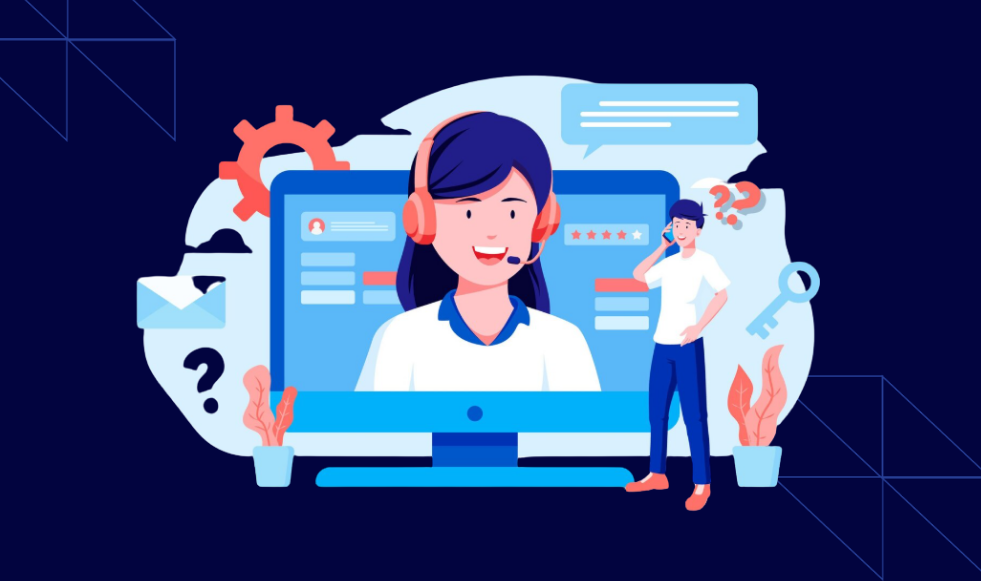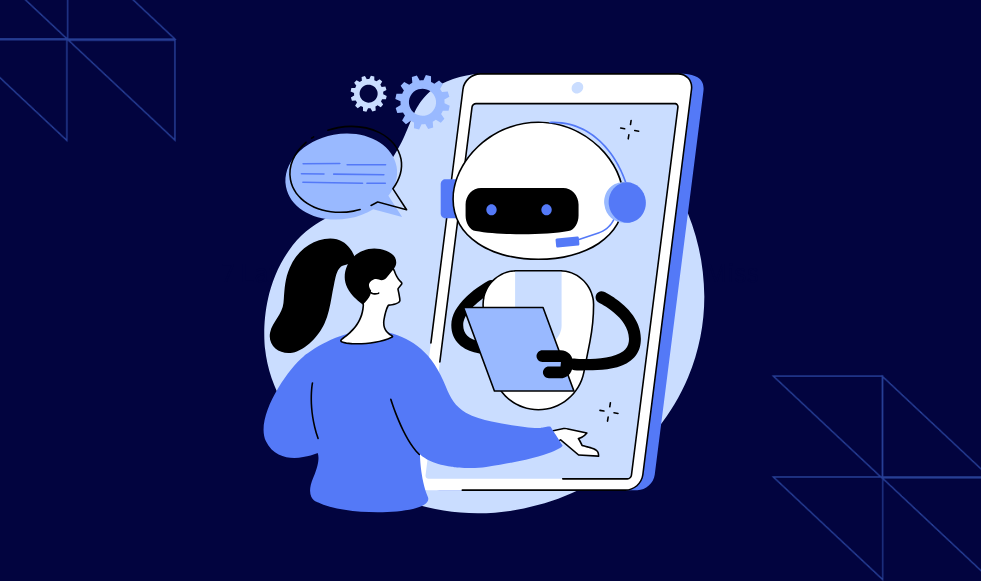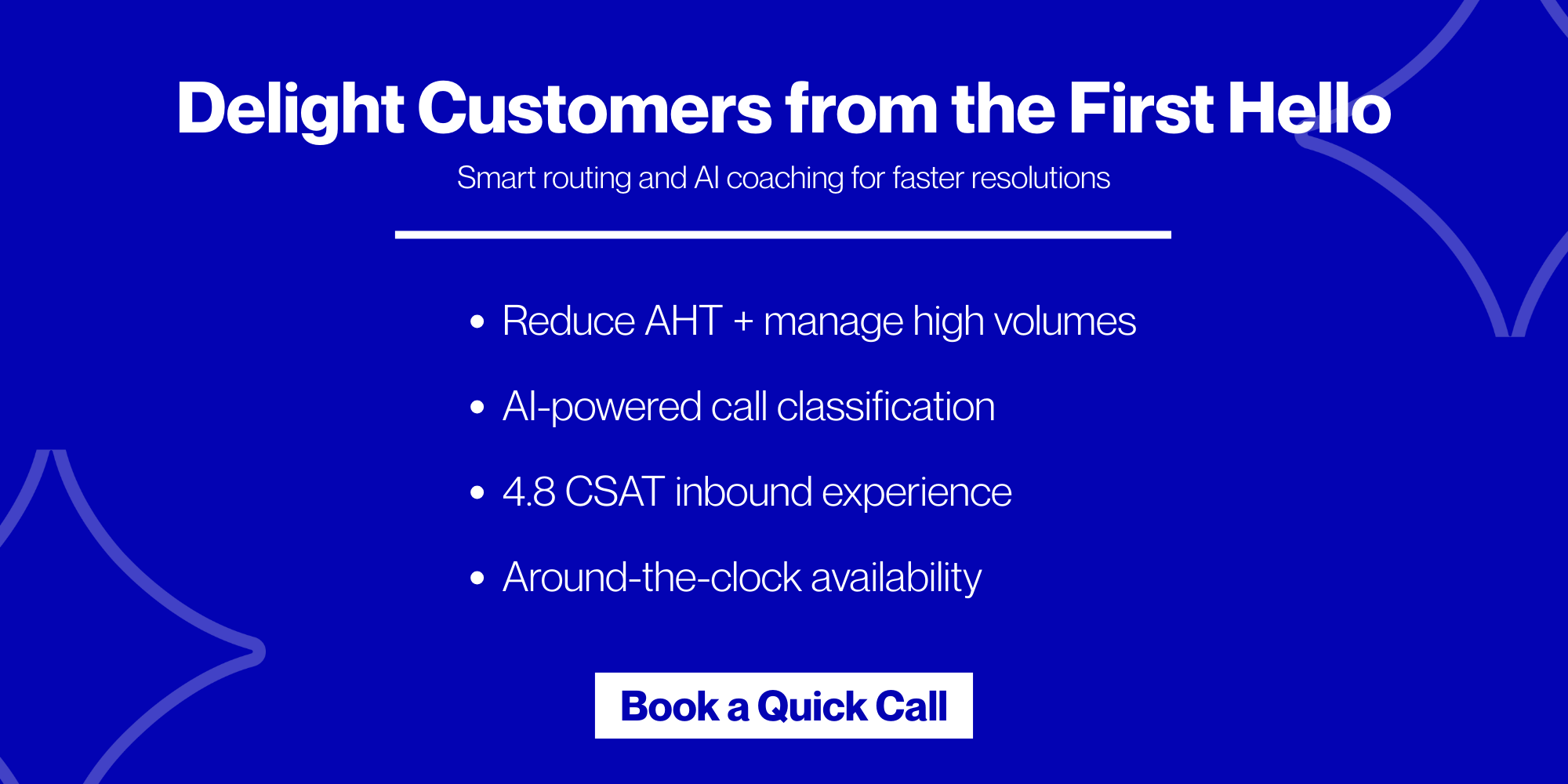An AI call center uses artificial intelligence to manage customer calls and messages. It is based on the latest technologies like speech recognition, natural language processing, sentiment analysis, and machine learning. In 2025, businesses are using it to control costs and minimize customer wait and hold times.
In 2025, full-fledged call center automation has become a reality! A Gartner study found that automation is projected to handle 10% of all customer interactions by 2026, up from just 1.6% in 2022. That’s more than a fivefold jump in only four years!
But what does this mean? For every call, chat, or email that used to demand a human agent could now be managed by an intelligent system. This system is known as an AI call center.
As per the latest AI trends, this technology can:
- Understand natural speech
- Detect emotions
- Resolve customer queries with minimal human input
The benefit? Lower support costs + high customer satisfaction. Read this article to check out the seven latest AI call center trends of 2025 to learn how businesses are using this technology for better growth and customer loyalty. But firstly, let’s understand what an AI call center is and the technology behind it.
What is an AI Call Center?

An AI call center uses virtual customer support assistants that can talk to your customers and handle their questions with minimal human effort. Instead of waiting for an employee to pick up the phone or respond in chat, these assistants can:
- Take the first call
and
- Understand what the customer wants
Next, if the query is routine/ repetitive, they can solve it on the spot. Whereas, if the issue is serious or complex, they escalate the matter and transfer it to your team of human agents.
Okay, but are businesses using this technology? Yes, a Deloitte report states that about 25% of enterprises using generative AI will deploy voice AI agents in their call centers by the end of 2025. This adoption is projected to double by 2027!
The Technology Behind AI Call Centers

An AI call center is not a standalone software! Instead, it is a collection of several major technologies. Each technology serves a different purpose, such as detecting emotions, learning from past responses, and more. Let’s understand in detail:
| AI Call Center Technologies | Function | Explanation |
| Natural Language Processing (NLP) | Understands natural human language | Modern voice assistants can understand what your customers are saying in normal or everyday language (not just fixed commands). |
| Speech Recognition | Listens and transcribes | An AI call center agent can listen to a customer on the phone and turn spoken words into text to process the request. |
| Sentiment Analysis | Reads customer mood | The virtual agents can tell if the customer sounds upset or calm. Next, they adjust the response accordingly. |
| Machine Learning | Learns from history | The AI call center improves over time by learning from past calls and outcomes. |
How An AI Call Center Manages Inbound Calls?
If we specifically talk about an AI-based inbound call center, the AI agents can:
- Answer common questions (like billing, order status, or service hours).
- Guide customers through simple processes (like resetting a password).
- Pass more complex issues to a human, but with full context, so the customer doesn’t have to repeat themselves.
The result? Lower call waiting times + Fewer routine tasks for your team = Faster service for customers. For most D2C companies and consumer brands earning $5M+ revenue, it’s like adding an extra team member who is always available and never runs out of capacity.
7 Latest AI Call Center Trends You Can’t Miss in 2025!

Studies show that by the end of 2025, about 95% of customer interactions will be handled by AI agents. But why such a craze? Because it’s profitable! Companies report an average ROI of $3.50 per $1 invested in AI customer service agents, with some leaders reaching up to 8x returns.
Still thinking AI is just an exaggerated technology? Change your opinion by reading these seven latest trends that show how AI call centers are getting used and helping businesses in 2025:
#Trend 1: “AI Co-Pilots” are Guiding Agents in Real Time
One of the biggest changes in call centers is how “agent assist” tools have evolved. In the past, these tools were slow. Agents had to manually search through knowledge bases or pre-set rules to find answers during calls. This wasted time and distracted them from the customer.
Now, AI copilots are changing the game! These tools:
- Listen to the live conversation
- Understand what the customer is asking
- Suggest the right responses and actions on the spot
Additionally, they also help with tone, accuracy, and even after-call tasks like summarizing or updating records. The benefit? Shorter calls + your agents are less stressed.
#Trend 2: Advanced Self-Service Offered by Conversational AI
Self-service used to mean FAQs, menu-based IVR systems, or basic chatbots that followed rigid scripts. These tools often frustrated customers because they couldn’t handle anything beyond simple questions.
But now, with generative AI, self-service is becoming conversational and intelligent. Modern chatbots based on conversational AI technology can:
- Understand customer intent
- Hold back-and-forth conversations
- Pull information directly from real-time systems like:
- Inventory
- Orders
- Support history
Moreover, they can also remember past interactions, so the customer doesn’t have to repeat information. Gartner predicts that by 2026, conversational AI in contact centers will cut labor costs by $80 billion globally.
#Trend 3: Predictive Call Routing
Traditional call routing makes customers go through long menus or connects them based only on agent skills. This wastes time and often leads to call transfers, which frustrates customers.
In 2025, call routing happens via artificial intelligence systems. These systems analyze data like:
- Past interactions
- Transaction history
- Customer mood in real time
Now, instead of waiting to hear “Press 1 for billing,” the system can already predict the reason for the call and route it to the best agent who is most likely to solve the issue. This leads to minimal hold times and fewer transfers.
The impact is already visible! Verizon, which handles 170 million calls every year, uses AI call center agents to correctly identify customer intent 80% of the time. In 2024, this approach helped them prevent 100,000 customers from leaving.
#Trend 4: Quality Checks Are Performed by AI Systems
Most businesses still review only a small sample of calls manually! This leaves gaps in quality monitoring, which delays feedback to agents.
Now again, AI removes these limits by automatically analyzing every customer interaction (whether it’s phone, chat, email, or social). It can:
- Track sentiment changes during a call
- Check if compliance rules were followed
- Evaluate tone and accuracy
The best part? All of this happens in near real time! As a result, most VPs, directors, and senior managers of leading D2C companies are not required to wait weeks to find issues. They can see quality trends instantly and provide coaching while the agent is still active.
#Trend 5: Proactive Customer Service
Traditional call centers wait for the customer to reach out. But with AI, businesses can now predict problems in advance and contact the customer first. This is called “proactive service”.
For example,
- Say a payment fails.
- Now, an AI call center does not wait for the customer to call and complain.
- Instead, it notifies them instantly with a link to retry the payment.
Let’s understand how AI call centers make this possible:
| Steps AI Call Centers Offer Proactive Service | Explanation |
| AI Spots Risk Through Data |
|
| AI Triggers Outreach |
|
| Reduced Inbound Calls |
|
#Trend 6: Agentic AI Handles End-to-End Customer Support
So far, most AI call center tools have played only a support role:
- They guide agents
- They suggest answers
- They summarize conversations
But agentic AI goes further! It can act on its own to complete customer service tasks from start to finish (as per company-approved rules). Instead of being just a chatbot, agentic AI can:
- Start conversations
- Ask clarifying questions
- Pull data from your systems
- Update records
- Resolve requests like billing issues or service changes
It only escalates to a human when the situation is too complex. Some businesses are already using it to handle Tier 1 support and automate multi-step tasks. It is also widely used as a 24/7 backup during busy times.
#Trend 7: Omnichannel AI Manages Multiple Touchpoints
Today’s customers don’t stick to one channel. They might:
- Start with a chat
- Follow up on the email
- Then call if needed
In many businesses, this creates broken experiences! Why? That’s because each channel feels separate and forces customers to repeat themselves.
However, with omnichannel AI systems, all these touchpoints are connected. The system maintains the same context and tone whether the customer is on voice, chat, email, or even video. This leads to smooth handoffs between AI and human agents. Also, such omnichannel messaging solutions ensure the customer never feels like they’re starting over.

AI-Human Collaboration is the Best Approach in 2025! Hire Atidiv to Set it Up Today.
AI call center agents have helped companies cut service costs by up to $80 billion. This largely happens because of:
- AI-powered self-service, where customers get answers instantly without waiting for an agent.
- Call center automation, where routine tasks like call summaries or order updates are handled automatically.
- Proactive customer service, where your customers’ needs are predicted and they are contacted first
But you cannot rely solely on AI. The best results come from a balanced model, where AI handles the routine/ repetitive tasks, and your human agents manage complex issues.
Want to set up this customer support model in 2025? Instead of managing everything in-house, you can outsource to Atidiv. We are a leading customer experience solutions provider with 15+ years of expertise. Our expert team serves 20+ industries and offers a wide range of services, such as:
- Email support services
- Social media support
- Omnichannel messaging solutions
- Back office support services, and more
To know more about how we operate, book a free consultation today!
AI Call Center FAQs
1. Which business functions/ departments are using AI call center agents in 2025?
A recent survey found that the highest usage of AI agents is in customer service, where AI is handling nearly 80% of routine inquiries (L1/ L2 level issues). Some other functions where AI is being used are:
- Sales
- Marketing
- Analytics
- HR/ Project management
2. Can AI call center agents fully replace human agents?
No! Most businesses use AI agents only for handling repetitive and rule-based tasks. That’s because they lack empathy and complex judgment. Thus, your D2C company or consumer brand will still require human agents for sensitive queries and high-stakes issues.
Need the best setup? You can go for a “hybrid model” where AI handles routine tasks, while your staff manages higher-value conversations.
3. What are the upfront costs of using AI agents for a small business?
Costs vary by provider! However, most AI call center agent providers usually follow a subscription or usage-based model. They offer a tiered pricing plan where you can start from low and opt for higher plans as your business grows. This avoids large upfront investments in infrastructure.
4. Can AI call center agents improve customer satisfaction?
Studies show that more than 31% of contact center managers are planning to implement AI specifically to increase customer satisfaction. This happens because AI agents:
- Reduce waiting times and hold times
- Provide consistent answers
- Are available 24/7
As a result, customers get quick resolutions for common issues, which directly boosts satisfaction and loyalty.
5. What risks should I consider before adopting AI call center agents?
As a business owner, you should consider the following major risks:
- Poor training data can lead to wrong answers
- Over-reliance on call-center automation can lead to mismanagement of complex issues
- More customer frustration if handoffs to people aren’t smooth
Want to avoid these risks? You should choose the right provider with strong expertise in your business area. Atidiv serves in 20+ industries and combines both AI + trained human agents. Schedule a free call to know more.
